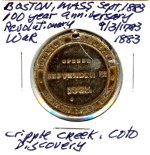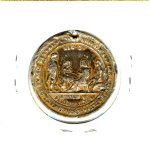vlad
Well-known member
According to their website this detector hit the market in April of 1978. Its a VLF Analytical at 4.5 kHz that had a 2D, 8" loop that classified targets as ferrous
or non ferros by meter. ( non motion I.B.) The meter had two colors and the left half was red, for iron, and the right half was green for conductive, and after analysis it
would go into an auto pinpoint mode. The target center would be under a black dot near the front of the loop. It had four controls: on the right front was the off/on/ gain,
and on the opposite side is a momentary on for battery check [ 2, 9 volt batteries.] On the rear the other two controls, threshold, and meter center. The two worked
together in small adjustments to get the tone set to your comfort of loudness, then just center the meter. I've read accounts of people complaining of drift
and constant readjustment of the two rear controls-no retune button-but I have never experienced that except around 60 cycle interference and running a lot of gain,
and that was being almost under major high tension lines.
With no outside pot for ground balance, I just set the loop on the ground, adjust the detector, and, lifting the loop experience no change in the threshold.
The 120B won't break any records in depth on coin sized conductive targets, but its sensitivity to iron is phenomenal, and it pegs the meter fast! Here's the
rule of thumb, if the needle moves right into the green, or doesn't move at all (conductive at the extreme limit ) dig. Something else you learn from use;
if the meter goes left into the red slowly, there is a very good chance of a conductive target being close to iron. All targets give audio, and linear iron
will also cause a blip-blip. If it goes left into the red, leave it, with the exception of one atypical reading.
How good is its ability to recognize iron? Very small from being hard to see, you need to sift throught the dirt. Bottlecaps and rusty washers, not a problem.
A bunch of nails, the same. Try a ratlroad spike or horseshoe, rub them on the coil-iron. How about a garbage can lid, iron; set it on the lid, iron; put it
IN the garbage can, iron. So many really high dollar detectors seeing iron as conductive seems like a good reason to keep it for iron infested sites.
We have a lot of old parking lots packed hard with sea shells that used to be places to eat and have the bottkecaps ( Cajuns drink beer not pop and lots of it )
)
and working with a partner to i.d. conductive trash really pays off.
It was followed up by the 130B which was a little hotter, but for dome reason did not have as much meter sensitivity as the 120B. If you should come across one
on ebay you might give it some serious thought. If it don't work, Keith Wills at East Texas Metal Detectors in Gilmer, will get it working.
http://compass-metal-detector-forum.548136.n2.nabble.com/file/n7582921/Arado_Detector1.jpg
or non ferros by meter. ( non motion I.B.) The meter had two colors and the left half was red, for iron, and the right half was green for conductive, and after analysis it
would go into an auto pinpoint mode. The target center would be under a black dot near the front of the loop. It had four controls: on the right front was the off/on/ gain,
and on the opposite side is a momentary on for battery check [ 2, 9 volt batteries.] On the rear the other two controls, threshold, and meter center. The two worked
together in small adjustments to get the tone set to your comfort of loudness, then just center the meter. I've read accounts of people complaining of drift
and constant readjustment of the two rear controls-no retune button-but I have never experienced that except around 60 cycle interference and running a lot of gain,
and that was being almost under major high tension lines.
With no outside pot for ground balance, I just set the loop on the ground, adjust the detector, and, lifting the loop experience no change in the threshold.
The 120B won't break any records in depth on coin sized conductive targets, but its sensitivity to iron is phenomenal, and it pegs the meter fast! Here's the
rule of thumb, if the needle moves right into the green, or doesn't move at all (conductive at the extreme limit ) dig. Something else you learn from use;
if the meter goes left into the red slowly, there is a very good chance of a conductive target being close to iron. All targets give audio, and linear iron
will also cause a blip-blip. If it goes left into the red, leave it, with the exception of one atypical reading.
How good is its ability to recognize iron? Very small from being hard to see, you need to sift throught the dirt. Bottlecaps and rusty washers, not a problem.
A bunch of nails, the same. Try a ratlroad spike or horseshoe, rub them on the coil-iron. How about a garbage can lid, iron; set it on the lid, iron; put it
IN the garbage can, iron. So many really high dollar detectors seeing iron as conductive seems like a good reason to keep it for iron infested sites.
We have a lot of old parking lots packed hard with sea shells that used to be places to eat and have the bottkecaps ( Cajuns drink beer not pop and lots of it
 )
)and working with a partner to i.d. conductive trash really pays off.

It was followed up by the 130B which was a little hotter, but for dome reason did not have as much meter sensitivity as the 120B. If you should come across one
on ebay you might give it some serious thought. If it don't work, Keith Wills at East Texas Metal Detectors in Gilmer, will get it working.
http://compass-metal-detector-forum.548136.n2.nabble.com/file/n7582921/Arado_Detector1.jpg



